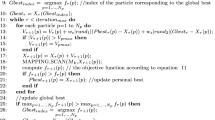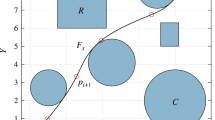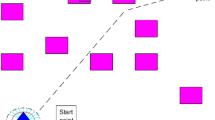Abstract
Mobile robot localization is a complex task, specially in unstructured indoor environments, due to noise and wrong scan-to-map association. The localization procedure becomes critical when the vehicle has low confidence about its last pose estimate, situation that requires a global localization procedure. An intuitive approach to solve the Global Localization Problem (GLP) is to distribute several pose hypotheses all over the map and select the most likely one according to an optimization heuristic such as Monte Carlo, Swarm Intelligence or Evolutionary Algorithm. However, hardware limitations and environment characteristics may affect the localization efficacy. Furthermore, we found relatively few studies exploring the effectiveness and the computing cost of different localization methods under different scenarios e.g. offices, corridors and big warehouses. In this work, we analyze different global localization methods based on multi-hypothesis optimization metaheuristics. We use the scan-to-map matching error computed by a pose tracking algorithm, the Perfect Match (PM), as the metric to score the hypotheses. Our main contribution is to propose an enhanced localization system by integrating a multi-hypothesis global localization method with the PM. We also analyzed different optimization heuristics applied to the GLP under typical and special conditions. Using simulations and real-world experiments, we measured the success rate and computing cost using several population sizes. Results show that studied methods perform differently in distinct scenarios, but our proposals based on Genetic Algorithm (GA) and Particle Swarm Optimization (PSO) showed an average success rate above 83%, while other methods did not achieved 80%. Furthermore, PM-based methods exhibit lower computing cost when compared to the traditional Adaptive Monte Carlo Localization (AMCL) after the 100th iteration. In summary, our study shows that the GA-based proposal, which performed slightly better than the PSO-based, represents the best candidate to integrate a robust localization system.
Similar content being viewed by others
Explore related subjects
Discover the latest articles, news and stories from top researchers in related subjects.Code and Data Availability
The source code developed by the authors for this study and the datasets generated during and analyzed during the current study are available from the corresponding author on reasonable request. The Perfect Match software, whose source code was used under license for the current study, is a third party property and so is not publicly available. The Intel Research Lab dataset is a public domain resource under license “Creative Commons CC0 1.0 Universal” and was obtained from the digital repository for MIT’s research DSpace@MIT, available at https://dspace.mit.edu/handle/1721.1/62287.
References
Corke, P.: Robotics, Vision and Control: Fundamental Algorithms in MATLAB® Second, completely revised, vol. 118. Springer, Cham (2017). https://doi.org/10.1007/978-3-642-20144-8
Joubert, D., Brink, W., Herbst, B.: Pose uncertainty in occupancy grids through monte carlo integration. J. Intell. Robot. Syst. 77(1), 5–16 (2015). https://doi.org/10.1007/s10846-014-0093-y
Thrun, S., Burgard, W., Fox, D.: Probabilistic Robotics. MIT Press, Cambridge (2005)
Almeida, T., Santos, V., Mozos, O.M., Lourenço, B.: Comparative analysis of deep neural networks for the detection and decoding of data matrix landmarks in cluttered indoor environments. J. Intell. Robot. Syst. 103(1), 1–14 (2021). https://doi.org/10.1007/s10846-021-01442-x
Digiacomo, F., Bologna, F., Inglese, F., Stefanini, C., Milazzo, M.: MechaTag: A mechanical fiducial marker and the detection algorithm. J. Intell. Robot. Syst. 103(3), 1–11 (2021). https://doi.org/10.1007/s10846-021-01507-x
Pei, F., Zhu, M., Wu, X.: A decorrelated distributed EKF-SLAM system for the autonomous navigation of mobile robots. J. Intell. Robot. Syst. 98(3), 819–829 (2020). https://doi.org/10.1007/s10846-019-01069-z
Prakash, K., Mohamed, M.N.G., Chakravorty, S., Hasnain, Z.: Structure aided Odometry (SAO): A novel analytical Odometry technique based on semi-absolute localization for precision-warehouse robotic assistance in environments with low feature variation. J. Intell. Robot. Syst. 102(4), 1–24 (2021). https://doi.org/10.1007/s10846-021-01427-w
Sobreira, H., Rocha, L., Costa, C., Lima, J., Costa, P., Moreira, A.P.: 2D cloud template matching - a comparison between iterative closest point and perfect match. In: 2016 International Conference on Autonomous Robot Systems and Competitions (ICARSC), pp 53–59 (2016). https://doi.org/10.1109/ICARSC.2016.13
Filotheou, A., Tsardoulias, E., Dimitriou, A., Symeonidis, A., Petrou, L.: Pose selection and feedback methods in tandem combinations of particle filters with scan-matching for 2D mobile robot localisation. J. Intell. Robot. Syst. 100(3), 925–944 (2020). https://doi.org/10.1007/s10846-020-01253-6
Lauer, M., Lange, S., Riedmiller, M.: Calculating the perfect match: an efficient and accurate approach for robot self-localization. In: Bredenfeld, A., Jacoff, A., Noda, I., Takahashi, Y. (eds.) Robot Soccer World Cup, pp 142–153. Springer, Berlin (2005). https://doi.org/10.1007/11780519_13
Sobreira, H., Costa, C.M., Sousa, I., Rocha, L., Lima, J., Farias, P., Costa, P., Moreira, A.P.: Map-matching algorithms for robot self-localization: a comparison between perfect match, iterative closest point and normal distributions transform. J. Intell. Robot. Syst. 93(3), 533–546 (2019). https://doi.org/10.1007/s10846-017-0765-5
Zhang, L., Zapata, R., Lépinay, P.: Self-adaptive monte carlo localization for mobile robots using range sensors. In: 2009 IEEE/RSJ International Conference on Intelligent Robots and Systems, pp 1541–1546 (2009), https://doi.org/10.1109/IROS.2009.5354298
Pinto, M., Sobreira, H., Moreira, A.P., Mendonca̧, H., Matos, A.: Self-localisation of indoor mobile robots using multi-hypotheses and a matching algorithm. Mechatronics 23(6), 727–737 (2013). https://doi.org/10.1016/j.mechatronics.2013.07.006
Campbell, S., O’Mahony, N., Carvalho, A., Krpalkova, L., Riordan, D., Walsh, J.: Where am I? localization techniques for mobile robots a review. In: 2020 6th International Conference on Mechatronics and Robotics Engineering (ICMRE), pp 43–47 (2020). https://doi.org/10.1109/ICMRE49073.2020.9065135
Wu, Z., Zhang, J., Yue, Y., Wen, M., Jiang, Z., Zhang, H., Wang, D.: Infrastructure-free global localization in repetitive environments: An overview. In: IECON 2020 The 46th Annual Conference of the IEEE Industrial Electronics Society, pp 626–631 (2020). https://doi.org/10.1109/IECON43393.2020.9255046
Ivanjko, E., Petrovic, I.: Extended Kalman filter based mobile robot pose tracking using occupancy grid maps. In: Proceedings of the 12th IEEE Mediterranean Electrotechnical Conference (IEEE Cat. No.04CH37521), vol. 1, pp 311–3141 (2004). https://doi.org/10.1109/MELCON.2004.1346851
Minguez, J., Montesano, L., Lamiraux, F.: Metric-based iterative closest point scan matching for sensor displacement estimation. IEEE Trans. Robot. 22(5), 1047–1054 (2006). https://doi.org/10.1109/TRO.2006.878961
Konecny, J., Prauzek, M., Hlavica, J.: ICP algorithm in mobile robot navigation: Analysis of computational demands in embedded solutions. IFAC-PapersOnLine 49(25), 396–400 (2016). https://doi.org/10.1016/j.ifacol.2016.12.079
Se, S., Lowe, D., Little, J.: Mobile robot localization and mapping with uncertainty using scale-invariant visual landmarks. Int. J. Robot. Res. 21(8), 735–758 (2002). https://doi.org/10.1177/027836402761412467
Choi, J., Maurer, M.: Hybrid map-based SLAM with Rao-Blackwellized particle filters. In: 17th International Conference on Information Fusion (FUSION), pp 1–6, Salamanca, Spain (2014)
Lee, H., Chun, J., Jeon, K., Lee, H.: Efficient EKF-SLAM algorithm based on measurement clustering and real data simulations. In: 2018 IEEE 88th Vehicular Technology Conference (VTC-Fall), pp 1–5 (2018). https://doi.org/10.1109/VTCFall.2018.8690802
Joo, S.-H., Lee, U.-H., Kuc, T.-Y., Park, J.-K.: A robust SLAM algorithm using hybrid map approach. In: 2018 International Conference on Electronics, Information, and Communication (ICEIC), pp 1–2 (2018). https://doi.org/10.23919/ELINFOCOM.2018.8330614
Bouraine, S., Bougouffa, A., Azouaoui, O.: Particle swarm optimization for solving a scan-matching problem based on the normal distributions transform. Evol. Intel., 1–12. https://doi.org/10.1007/s12065-020-00545-y (2021)
Chien, C.-H., Wang, W.-Y., Jo, J., Hsu, C.-C.: Enhanced monte carlo localization incorporating a mechanism for preventing premature convergence. Robotica 35(7), 1504 (2017). https://doi.org/10.1017/S026357471600028X
Yilmaz, A., Temeltas, H.: Self-adaptive monte carlo method for indoor localization of smart AGVs using LIDAR data. Robot. Auton. Syst. 122, 103285 (2019). https://doi.org/10.1016/j.robot.2019.103285
AbuAlkebash, H., Hasan, O.: Improved global localization and resampling techniques for Monte Carlo localization algorithm. Int. J. Appl. Math. Electron. Comput. 8(3), 102–108 (2020). https://doi.org/10.18100/ijamec.800166
Chien, C.-H., Hsu, C.-C., Wang, W.-Y., Kao, W.-C., Chien, C.-J.: Global localization of Monte Carlo localization based on multi-objective particle swarm optimization. In: 2016 IEEE 6th International Conference on Consumer Electronics - Berlin (ICCE-Berlin), pp 96–97 (2016). https://doi.org/10.1109/ICCE-Berlin.2016.7684728
Chien, C.-H., Wang, W.-Y., Hsu, C.-C.: Multi-objective evolutionary approach to prevent premature convergence in Monte Carlo localization. Appl. Soft Comput. 50, 260–279 (2017). https://doi.org/10.1016/j.asoc.2016.11.020
Peng, G., Zheng, W., Lu, Z., Liao, J., Hu, L., Zhang, G., He, D.: An improved AMCL algorithm based on laser scanning match in a complex and unstructured environment. Complexity 2018. https://doi.org/10.1155/2018/2327637 (2018)
Martín, F., Moreno, L., Garrido, S., Blanco, D.: Kullback-Leibler divergence-based differential evolution Markov Chain filter for global localization of mobile robots. Sensors 15(9), 23431–23458 (2015). https://doi.org/10.3390/s150923431
Moreno, L., Martín, F., Muñoz, M.L., Garrido, S.: Differential evolution Markov Chain filter for global localization. J. Intell. Robot. Syst. 82(3-4), 513–536 (2016). https://doi.org/10.1007/s10846-015-0245-8
Zhang, Q., Wang, P., Bao, P., Chen, Z.: Mobile robot global localization using particle swarm optimization with a 2D range scan. In: Proceedings of the 2017 International Conference on Robotics and Artificial Intelligence, pp 105–109 (2017). https://doi.org/10.1145/3175603.3175618
Zhang, Q.-B., Wang, P., Chen, Z.-H.: An improved particle filter for mobile robot localization based on particle swarm optimization. Expert Syst. Appl. 135, 181–193 (2019). https://doi.org/10.1016/j.eswa.2019.06.006
Pinto, A.M., Moreira, A.P., Costa, P.G.: A localization method based on map-matching and particle swarm optimization. J. Intell. Robot. Syst. 77(2), 313–326 (2015). https://doi.org/10.1007/s10846-013-0009-2
Vahdat, A.R., NourAshrafoddin, N., Ghidary, S.S.: Mobile robot global localization using differential evolution and particle swarm optimization. In: 2007 IEEE Congress on Evolutionary Computation, pp 1527–1534 (2007), https://doi.org/10.1109/CEC.2007.4424654
Neto, W.A., Pinto, M.F, Marcato, A.L., da Silva, I.C., Fernandes, D.D.A.: Mobile robot localization based on the novel leader-based bat algorithm. J. Control Autom. Electr. Syst. 30(3), 337–346 (2019). https://doi.org/10.1007/s40313-019-00453-2
Nedjah, N., de Oliveira, P.J.A., et al.: Simultaneous localization and mapping using swarm intelligence based methods. Expert Syst. Appl. 159, 113547 (2020). https://doi.org/10.1016/j.eswa.2020.113547
Holland, J.H.: Adaptation in Natural and Artificial Systems: an Introductory Analysis with Applications to Biology, Control, and Artificial Intelligence. MIT Press, Cambridge (1992)
Gao, H., Zhang, X., Yuan, J., Song, J., Fang, Y.: A novel global localization approach based on structural unit encoding and multiple hypothesis tracking. IEEE Trans. Instrum. Meas. 68(11), 4427–4442 (2019). https://doi.org/10.1109/TIM.2018.2890455
Carvalho, J.L.C., Farias, P.C.M.A., de Souza, E.E.P., de Simas Filho, E.F.: Particle swarm localization for mobile robots using a 2D laser sensor. In: 2019 8th Brazilian Conference on Intelligent Systems (BRACIS), pp 281–286 (2019). https://doi.org/10.1109/BRACIS.2019.00057
Pinto, M., Moreira, A.P., Matos, A., Sobreira, H.: Novel 3D matching self-localisation algorithm. Int. J. Adv. Eng. Technol 5(1), 1–12 (2012)
Sobreira, H., Pinto, M., Moreira, A.P., Costa, P.G., Lima, J.: Robust robot localization based on the perfect match algorithm. In: CONTROLO’2014–Proceedings of the 11th Portuguese Conference on Automatic Control, pp 607–616 (2015). https://doi.org/10.1007/978-3-319-10380-8_58
Farias, P., Sousa, I., Sobreira, H., Moreira, A.P.: Approach for supervising self-localization processes in mobile robots. In: EPIA Conference on Artificial Intelligence, pp 461–472. Springer (2017). https://doi.org/10.1007/978-3-319-65340-2_38
Shafii, N., Farias, P., Sousa, I., Sobreira, H., Reis, L.P., Moreira, A.P.: Autonomous interactive object manipulation and navigation capabilities for an intelligent wheelchair. In: EPIA Conference on Artificial Intelligence, pp 473–485. Springer (2017). https://doi.org/10.1007/978-3-319-65340-2_39
Fox, D., Burgard, W., Thrun, S.: Active Markov localization for mobile robots. Robot. Auton. Syst. 25(3-4), 195–207 (1998). https://doi.org/10.1016/S0921-8890(98)00049-9
Seifzadeh, S., Wu, D., Wang, Y.: Cost-effective active localization technique for mobile robots. In: 2009 IEEE International Conference on Robotics and Biomimetics (ROBIO), pp 539–543 (2009). https://doi.org/10.1109/ROBIO.2009.5420704
Gottipati, S.K., Seo, K., Bhatt, D., Mai, V., Murthy, K., Paull, L.: Deep active localization. IEEE Robot. Autom. Lett. 4(4), 4394–4401 (2019). https://doi.org/10.1109/LRA.2019.2932575
Andrade, F., LLofriu, M., Tanco, M.M., Barnech, G.T., Tejera, G.: Active localization for mobile service robots in symmetrical and open environments. In: 2021 Latin American Robotics Symposium (LARS), 2021 Brazilian Symposium on Robotics (SBR), and 2021 Workshop on Robotics in Education (WRE), pp 270–275 (2021). https://doi.org/10.1109/LARS/SBR/WRE54079.2021.9605406
Fox, D.: KLD-sampling: Adaptive particle filters and mobile robot localization. Adv. Neural Inform. Process. Syst. (NIPS) 14(1), 26–32 (2001)
Kennedy, J., Eberhart, R.: Particle swarm optimization. In: Proceedings of ICNN’95 - International Conference on Neural Networks, vol. 4, pp 1942–19484 (1995), https://doi.org/10.1109/ICNN.1995.488968
Eberhart, R.C., Shi, Y.: Comparing inertia weights and constriction factors in particle swarm optimization. In: Proceedings of the 2000 Congress on Evolutionary Computation. CEC00 (Cat. No.00TH8512), vol. 1, pp 84–881 (2000), https://doi.org/10.1109/CEC.2000.870279
Storn, R., Price, K.: Differential evolution – a simple and efficient heuristic for global optimization over continuous spaces. J. Global Optim. 11(4), 341–359 (1997). https://doi.org/10.1023/A:1008202821328
Price, K., Storn, R.M., Lampinen, J.A.: Differential Evolution: a Practical Approach to Global Optimization. Springer, Berlin (2006). https://doi.org/10.1007/3-540-31306-0
Grisetti, G., Stachniss, C., Burgard, W.: Improved techniques for grid mapping with Rao-Blackwellized particle filters. IEEE Trans. Robot. 23(1), 34–46 (2007). https://doi.org/10.1109/TRO.2006.889486
Kohlbrecher, S., von Stryk, O., Meyer, J., Klingauf, U.: A flexible and scalable slam system with full 3D motion estimation. In: 2011 IEEE International Symposium on Safety, Security, and Rescue Robotics, pp 155–160 (2011). https://doi.org/10.1109/SSRR.2011.6106777
Howard, A., Roy, N.: The Robotics Data Set Repository (Radish). http://radish.sourceforge.net/ (2003)
Funding
This work has received funding from the European Union’s Horizon 2020 research and innovation programme under the Grant Agreement N.777096 and from SEPIN/MCTI under the 4th Coordinated Call BR-EU in CIT.
Author information
Authors and Affiliations
Contributions
All authors (Carvalho, J.L.C., Farias, P.C.M.A. and Simas Filho, E.F.) contributed equally to the study conception, design of the experiments, data analysis and the paper writing/review. Carvalho, J.L.C. and Farias, P.C.M.A. were responsible for the experiments planning, setup and generation of the dataset. Carvalho, J.L.C. developed the source code of the proposed methods, the scripts for data analysis and conducted the execution of the experiments.
Corresponding author
Ethics declarations
Ethics approval
Ethics approval is not applicable to the study.
Consent to Participate
Consent to participate is not applicable to the study.
Consent for Publication
Consent for publication is not applicable to the study.
Competing interests
The authors have no relevant financial or non-financial interests to disclose.
Additional information
Publisher’s Note
Springer Nature remains neutral with regard to jurisdictional claims in published maps and institutional affiliations.
Rights and permissions
Springer Nature or its licensor (e.g. a society or other partner) holds exclusive rights to this article under a publishing agreement with the author(s) or other rightsholder(s); author self-archiving of the accepted manuscript version of this article is solely governed by the terms of such publishing agreement and applicable law.
About this article
Cite this article
Carvalho, J.L.C., Farias, P.C.M.A. & Simas Filho, E.F. Global Localization of Unmanned Ground Vehicles Using Swarm Intelligence and Evolutionary Algorithms. J Intell Robot Syst 107, 45 (2023). https://doi.org/10.1007/s10846-023-01813-6
Received:
Accepted:
Published:
DOI: https://doi.org/10.1007/s10846-023-01813-6




